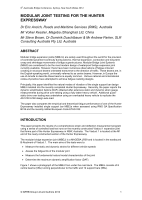Bridges

Modular Joint Testing for the Hunter Expressway
- Publication no: ABC-DES804-14
- Published: 22 October 2014
- PDF (free) Download
Modular bridge expansion joints (MBEJs) are widely used throughout the world for the provision of controlled pavement continuity during seismic, thermal expansion, contraction and long-term creep and shrinkage movements of bridge superstructures. Modular bridge joint systems are considered to be the most modern design of waterproof bridge expansion joint currently available. However, there have been numerous observations of fatigue-induced cracking in structural beams orientated transverse to the direction of traffic. These beams are, in the English-speaking world, universally referred to as centre beams. However, in Europe the use of lamella to describe these beams is equally common. Various national and international codes-of-practice have attempted to achieve fatigue-resisting designs.Principally, this paper identifies the natural modes of vibration of the single support bar design MBEJ installed into the recently completed Hunter Expressway. Secondly, the paper reports the dynamic amplification factors obtained after extensive static and dynamic strain gauge measurements during drive-over testing using a fully laden heavy vehicle. Additional quasi-static drive-over testing was undertaken using an overloaded heavy vehicle to replicate the AS 5100 A160 design axle load.The paper also compares the empirical and theoretical fatigue performance of one of the Hunter Expressway installed single support bar MBEJs when assessed using RMS QA Specification B316 and the recently ratified European Code ETAG 032.
Related publications
ABC2022-110-22
Latest Bridges News
